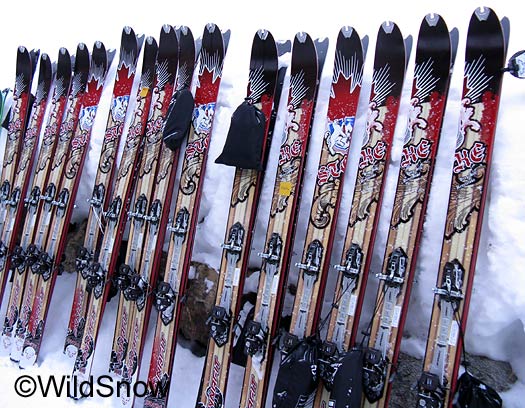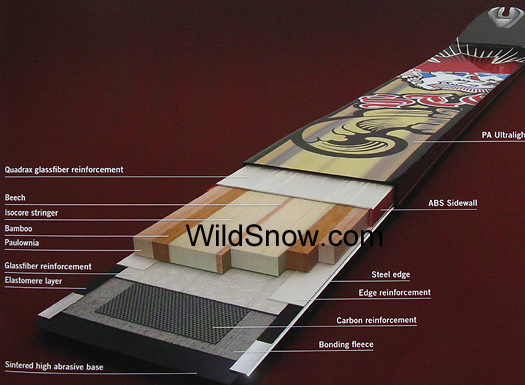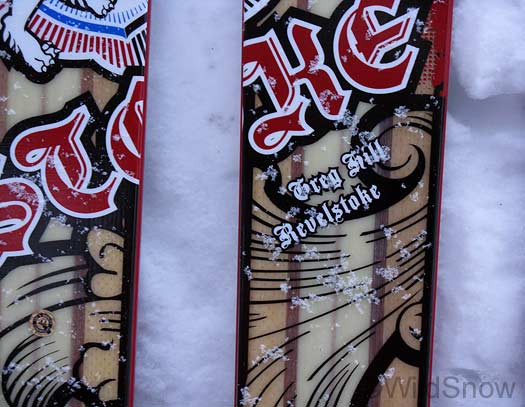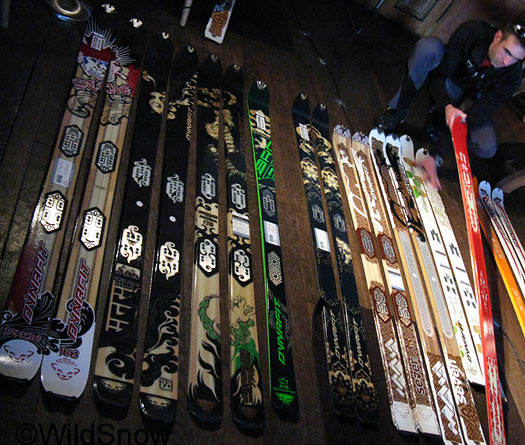Dynafit’s 2010/11 ski line gets fatter and more “freeride” oriented with the addition of their 129/105/119 “Stoke” model.

Stoke is named after Revelstoke, Canada, with design influence by Greg Hill. Available in 164, 173, and 182.
Along with the now classic and well liked Manaslu and Seven Summits models (among others), this year we are treated to Dynafit’s first “freeride” width plank. This ski’s design was influenced by well known ski mountaineer Greg Hill and the needs of skiers in areas such as Revelstoke, Canada, where consistent dumps of loose snow make wider planks an extremely useful tool for ski alpinism. Combine the 105 mm waist width with Dynafit’s lightweight construction, and you get a ski that is said to handle well, but only compresses the scale with 1550 grams for the 173 length (not verified).
If the production Stoke skis can stick to this weight, that’ll put them in the class of a K2 Baker SL or Dynafit Manaslu in terms of surface area vs mass, which could make this a superb choice for human powered sliders who want something in a freeride width.

Dynafit Revelstoke Stoke skis march together, Euro style.
How does the Stoke ski? I’m not qualified to evaluate a freeride board as I don’t ski other skis of that width enough for perspective. But I quizzed a few of the guys at the Dynafit event who were used to that type of ski. They had no complaints. Some pointed out that a wide ski with less sidecut than some other freeride brands/models is a bit different (both pro and con), and that you do notice the lack of weight. Overall, everyone sounded pleased though some wondered if it could use some rocker. My take is that not all skis need rocker, and it can of course be detrimental to a skis hard snow performance, so let’s not make a god out of it.
If you’re looking for wider backcountry skis, pay attention to the Stoke and try to get on a pair when demos are available next winter. To that end, we’ll attempt to test a pair this winter in varied conditions, and do a real review. But meanwhile, we may have a winner that could even be a game changer such as the Manaslu.

Stoke ski construction includes carbon fiber and quite a bit of lightweight core material. Beyond exotic materials, however, Dynafit tells me that what makes a ski lighter weight is just being careful with how much resin gets left in during the molding process, along with not going overboard on the amount of glass fiber (using some carbon helps, as you get strength with minimal weight increases).

Stoke skis detail includes the Greg Hill and Canadian reference.
Beyond these being a super interesting develpment, the burning question is will we still see Greg Hill on Goode carbon skis, or only on his imprimatur plank? We’ll be watching.

Dynafit Broad Peak skis.
Dynafit’s other new ski, the Broad Peak (112/74/96 in 167 cm), is Stoke’s opposite. Built for edge hold when you encounter conditions such as white ice during ski descents of big peaks, the ski is still said to handle varied conditions, as a board of this sort would have to.
My take is that the Broad Peak is a quiver ski. You’d own it if you want something that’ll help you survive steep icy terrain you might encounter during spring ski descents and that sort of thing — or if you’re heading out for a quick blast up and down Broad Peak before your morning espresso. Available in 149, 158, 167, 176, weight will be just over one kilo per ski — another reason this might be the choice for gargantuan climbs.

Dynafit skis, the full lineup, from left to right: Stoke, Manaslu, Mustagh Ata SL, Broad Peak (green design), Nanga Parbat, 7 Summits and 7SSL, red Guide ski being held up, Haute Route Plus, yellow is some sort of special edition (probably the SAR ski), white race ski.
WildSnow.com publisher emeritus and founder Lou (Louis Dawson) has a 50+ years career in climbing, backcountry skiing and ski mountaineering. He was the first person in history to ski down all 54 Colorado 14,000-foot peaks, has authored numerous books about about backcountry skiing, and has skied from the summit of Denali in Alaska, North America’s highest mountain.
